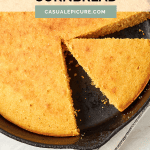This post may contain affiliate sales links. As an Amazon Associate, I earn from qualifying purchases. Please see my full disclaimer policy for details.

Classic family recipes offer a sense of comfort and connection to traditions, even amidst today’s evolving culinary trends. For me, no dish embodies this comfort more than old-fashioned cornbread. My Nana frequently made cornbread, alongside buttermilk biscuits, as a staple in her daily cooking. As a late-night treat, my Papa would often enjoy a simple combination of buttermilk and leftover cornbread.
This timeless family recipe is a masterpiece of simplicity and flavor, the ideal companion to a steaming bowl of of your favorite chili recipe. My version of this beloved recipe is sure to become a timeless fixture at your family’s table for generations to come.
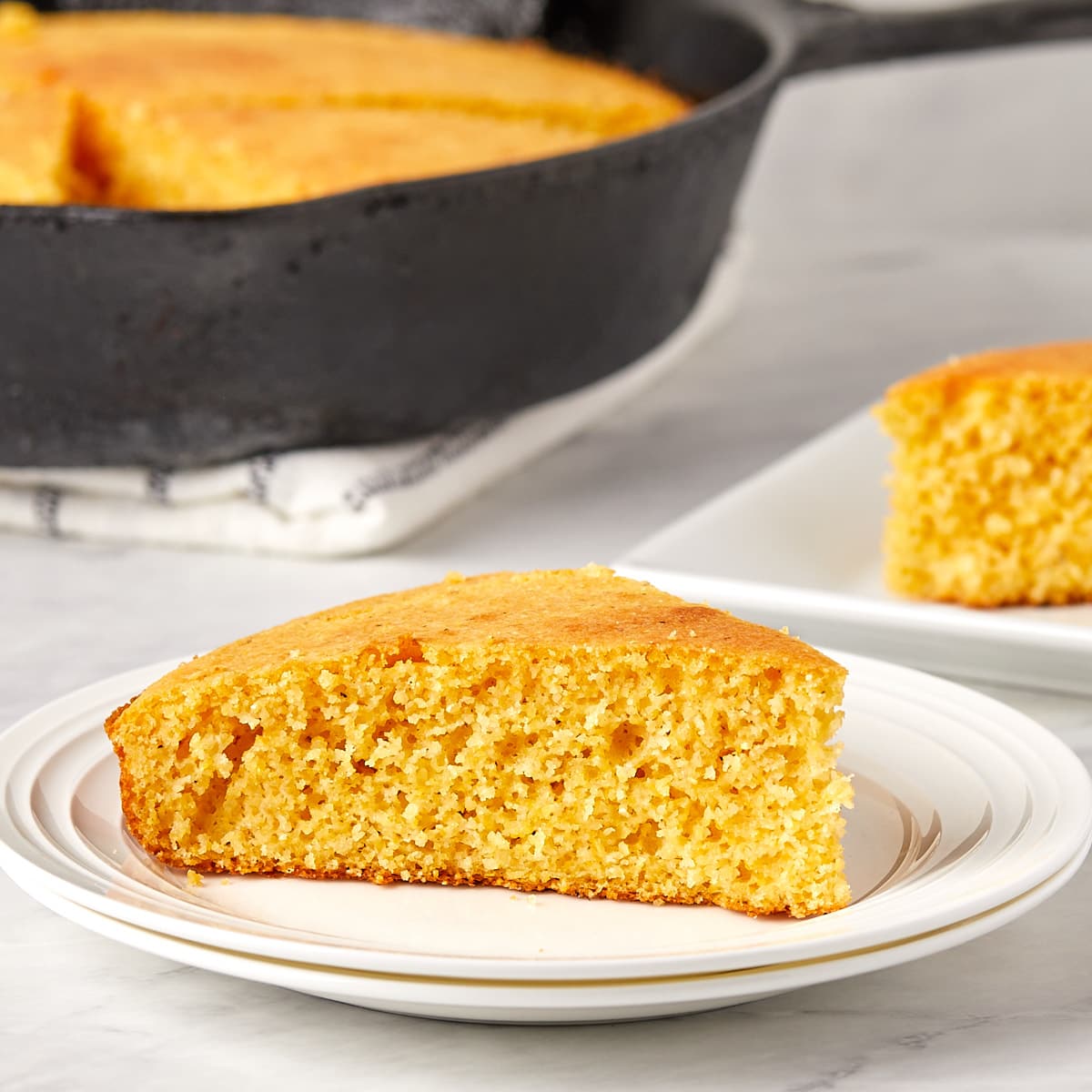
Southern Cornbread vs Regular Cornbread – What’s the Difference?
Southern cornbread and regular cornbread can vary in several ways, including ingredients, preparation methods, and flavor profiles. The primary differences between the two are often regional and cultural. Southern cornbread is typically made with cornmeal, buttermilk, and minimal sugar, resulting in a crumbly texture and savory flavor. Regular cornbread, on the other hand, often contains flour, sugar, and milk, resulting in a softer, sweeter, and less crumbly product. Both types of cornbread have their own unique characteristics and are enjoyed in their respective culinary contexts.
Ingredients
- Southern Cornbread: Traditional Southern cornbread typically contains just a few basic ingredients: cornmeal, buttermilk, salt, and sometimes a small amount of sugar. It doesn’t typically include flour or sugar in large quantities. The use of buttermilk gives it a tangy flavor and helps create a crumbly texture.
- Regular Cornbread: Regular or Northern-style cornbread can vary more in its ingredients. It often includes a combination of cornmeal and all-purpose flour, which results in a softer and less crumbly texture. Sugar is commonly added to regular cornbread recipes, giving it a slightly sweeter taste compared to the tangier Southern version. It may also be made with milk instead of buttermilk.
Texture
- Southern Cornbread: Southern cornbread is known for its crumbly and coarse texture. It tends to be denser and drier than regular cornbread, which makes it ideal for soaking up gravies and sauces.
- Regular Cornbread: Regular cornbread is softer, moister, and more cake-like in texture due to the inclusion of flour and often sugar. It may have a finer crumb and be slightly sweeter.
Sweetness
- Southern Cornbread: Authentic Southern cornbread is typically savory and not very sweet. It may have a subtle sweetness from the buttermilk but is not overtly sweet.
- Regular Cornbread: Regular cornbread is often sweeter due to the addition of sugar. The sweetness can vary from mildly sweet to quite sweet, depending on the recipe.
Crust
- Southern Cornbread: Southern cornbread is often cooked in a preheated cast-iron skillet or baking dish with hot oil, which creates a crisp and crunchy crust on the bottom and sides.
- Regular Cornbread: Regular cornbread may or may not have the same crispy crust as Southern cornbread. It is typically baked in a variety of pans, including round or square baking dishes.

Key Ingredients and Substitutions
The are no complex ingredients for old fashioned cornbread and for most home-bakers these will be pantry staples.
In the printable recipe below, you can find a complete list of ingredients and measurements.
- Cornmeal: We used an enriched yellow cornmeal for this recipe. There are lots of different cornmeal options -yellow, white, stoneground, self-rising, corn masa, and the list goes on. Yellow cornmeal (which is made from yellow corn) has a more robust flavor that produces a golden-colored cornbread. White cornmeal is made from white corn and has a subtler flavor that produces a lighter color of cornbread. Enriched cornmeal has added vitamins and minerals to replace some of the nutrients that are lost during processing.
- All-Purpose Flour: To get a better structure and a cornbread that is a little less crumbly the recipe includes flour.
- Rising Agents: This recipe uses both baking soda and baking powder to help get a nice rise to the cornbread.
- Buttermilk: To get a more tender cornbread as well as getting a richer, buttery flavor we prefer buttermilk over milk.
- Sugar: This can be a controversial ingredient in cornbread. This is not a sweet cornbread recipe since it only uses a teaspoon. Sugar will help promote the golden color as well improve the crumb texture.
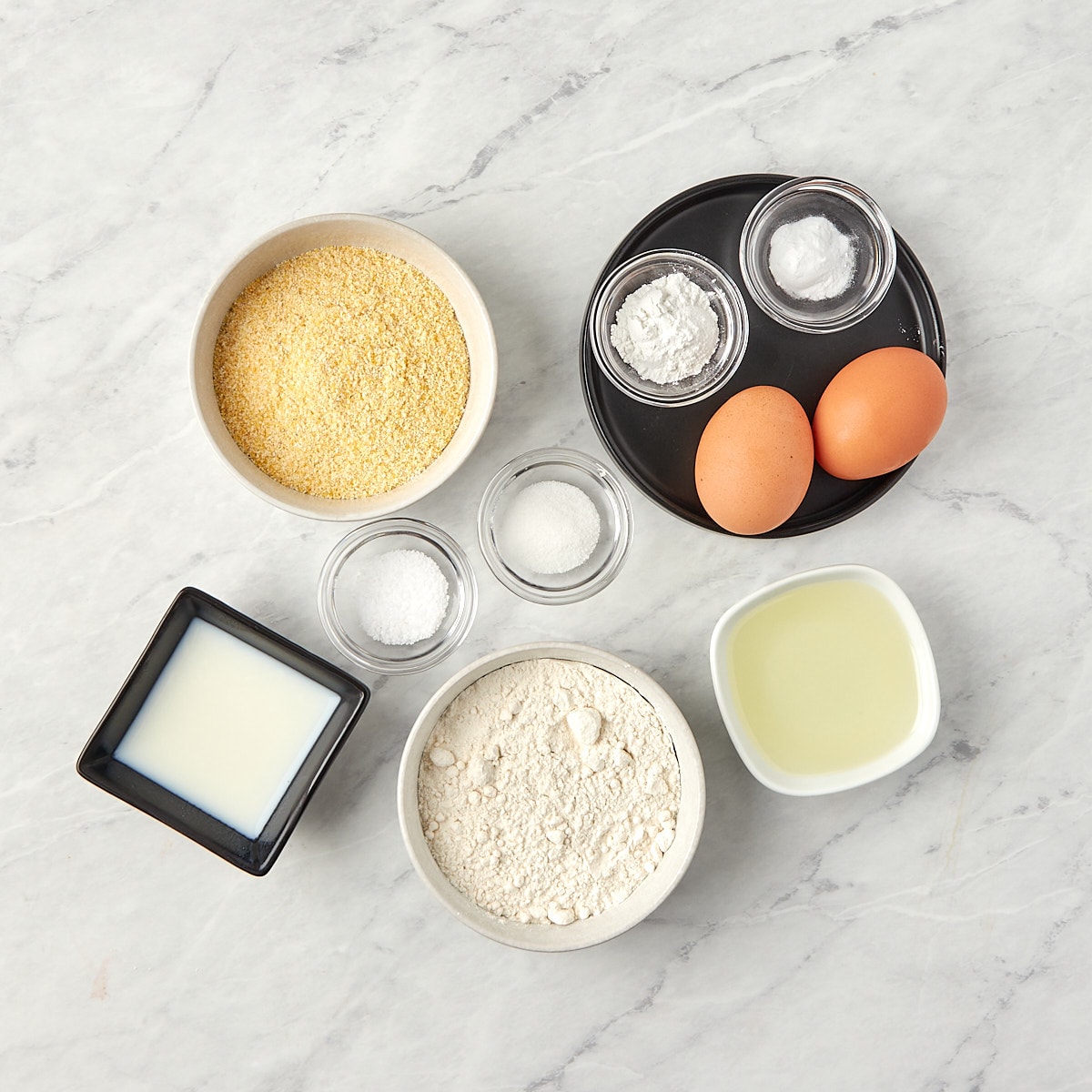
White vs Yellow Cornmeal – What’s the Difference?
White and yellow cornmeal are both made from corn, but they differ primarily in the type of corn used and their flavor, texture, and culinary applications. White cornmeal is milder in flavor and lighter in color, while yellow cornmeal has a stronger corn flavor and a vibrant yellow hue. The choice between them depends on the specific recipe and the desired flavor and appearance of the final dish. While we prefer yellow cornmeal for cornbread, you can substitute with white cornmeal for a lighter color and flavor.
Corn Variety
- White Cornmeal: White cornmeal is made from grinding dried white corn kernels. This type of cornmeal is milder in flavor and has a slightly sweeter taste compared to yellow cornmeal.
- Yellow Cornmeal: Yellow cornmeal is made from grinding dried yellow corn kernels. It has a more robust, earthy flavor and a distinct corn taste.
Flavor
- White Cornmeal: White cornmeal has a more neutral and delicate flavor, which makes it suitable for a wide range of recipes. It tends to absorb the flavors of other ingredients in dishes.
- Yellow Cornmeal: Yellow cornmeal has a stronger, cornier flavor that can be more pronounced in dishes. It imparts a distinct corn taste to recipes.
Texture
- Both white and yellow cornmeal can vary in texture, from fine to coarse. The texture can affect the final outcome of dishes. Fine cornmeal is often used for baking, while coarser varieties are used for dishes like polenta or grits.
Culinary Uses
- White Cornmeal: White cornmeal is often preferred for recipes where a neutral corn flavor is desired or where the color of the dish should remain light. It’s commonly used for baking, such as making cornbread, muffins, and pancakes.
- Yellow Cornmeal: Yellow cornmeal is frequently used in dishes where the robust corn flavor and golden color are desirable. It’s a popular choice for making cornbread, corn muffins, and Southern-style dishes like cornmeal-crusted fried fish or hushpuppies.
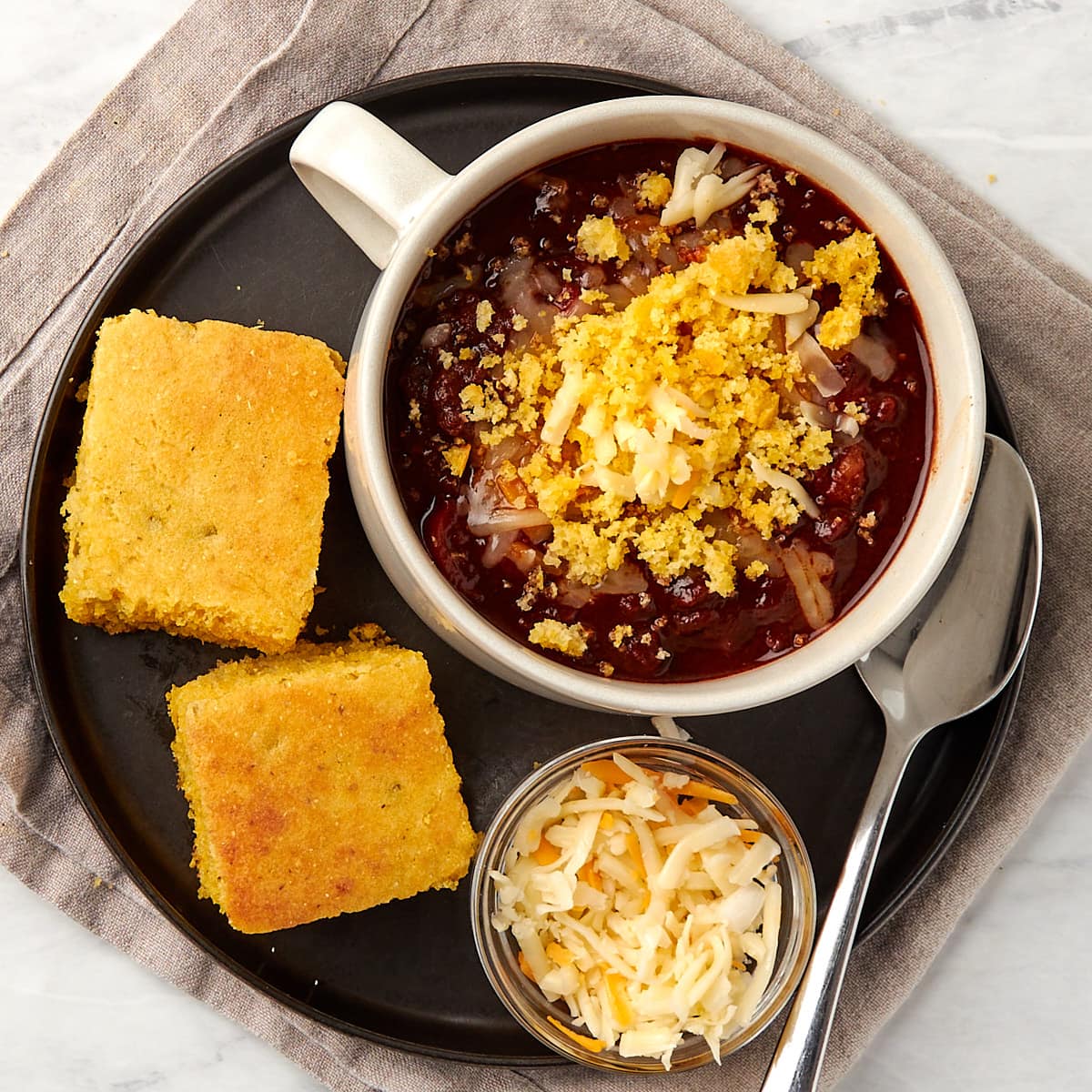
Butter or Oil – Which is Better?
The choice between butter and oil in your cornbread comes down to personal taste preferences and dietary considerations. If you want a richer, buttery flavor and don’t mind the denser texture, go for butter. If you prefer a lighter, moister, and more neutral-tasting cornbread or need a vegan option, then oil is a suitable choice. Some recipes even combine both butter and oil for a balance of flavor and moisture. Both butter and oil can be used effectively in cornbread recipes, and each has its advantages. Experimenting with different fats can be a fun way to discover your preferred cornbread style, so feel free to try both butter and oil to see which one you like best.
Butter
- Flavor: Butter imparts a rich, creamy, and slightly nutty flavor to cornbread. It can add a delightful buttery aroma and taste to the finished product.
- Texture: When you use butter in cornbread, it can contribute to a tender crumb and a slightly denser texture, which some people prefer. The milk solids in butter also help create a moist and flavorful cornbread.
- Crust: Butter can give your cornbread a deliciously crisp and golden crust when used to grease the baking pan.
Oil
- Moisture: Oil, especially neutral-flavored oils like vegetable or canola oil, can help ensure that your cornbread stays moist and tender. It can result in a lighter, fluffier texture.
- Flavor Neutrality: Unlike butter, which has a distinct flavor, using a neutral oil won’t overpower the cornmeal’s natural taste, allowing the cornbread’s flavor to shine.
- Vegan Option: Using vegetable oil can make your cornbread vegan-friendly if you are avoiding dairy products.
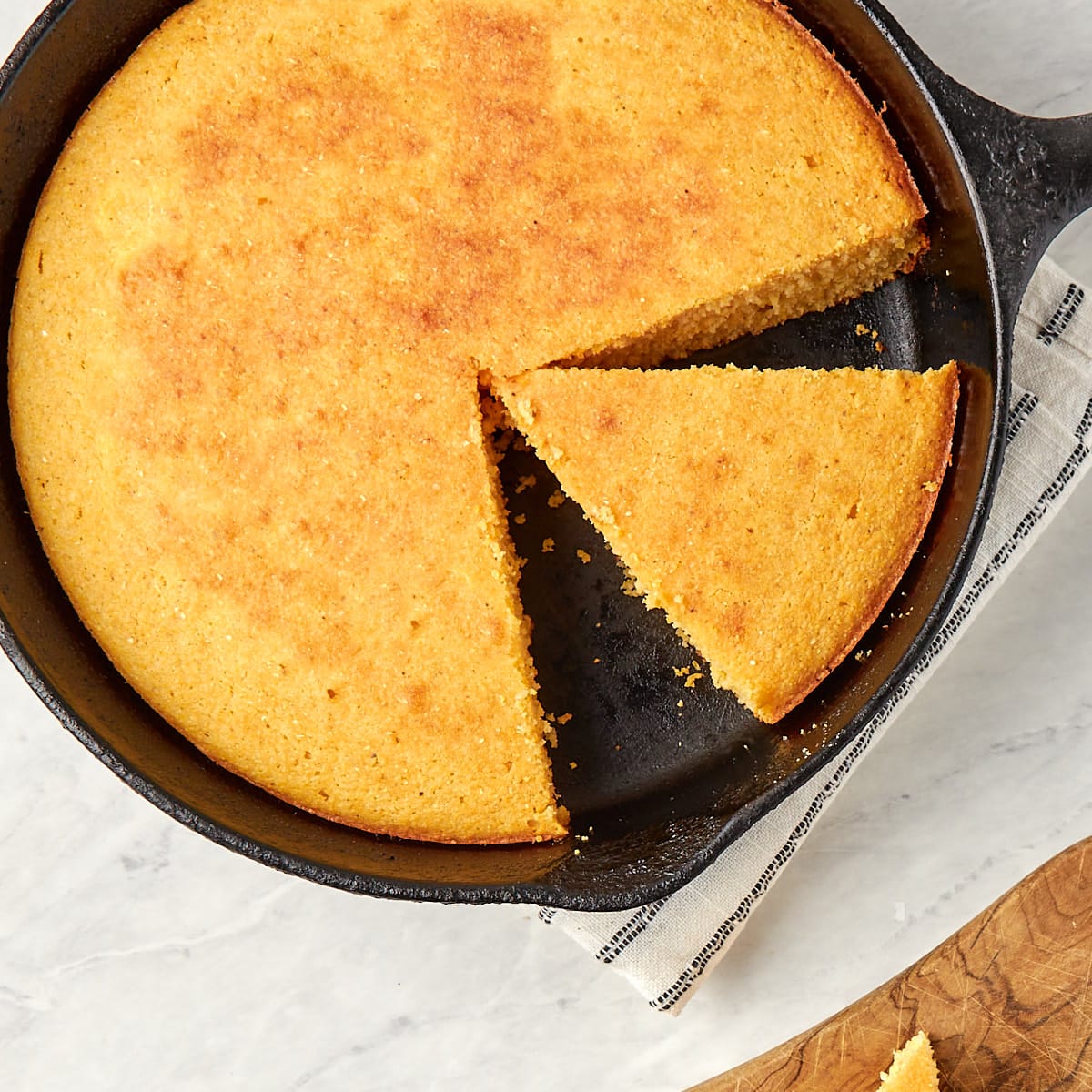
Cast Iron, Glass, or Metal Pan – Which is Better?
Cornbread can be baked in various types of pans, including glass, metal, and cast iron, each offering unique advantages and characteristics. The choice of pan depends on the desired result and personal preference. Cast iron is the preferred vessel for traditional Southern old fashioned cornbread since it creates that all important crispy crust.
Glass Baking Dish
- Even Heating: Glass pans distribute heat evenly, which can result in a more uniform cooking of the cornbread.
- Easy Monitoring: You can see the browning and cooking progress of the cornbread through the transparent glass.
- Non-reactive: Glass is non-reactive, so it won’t interact with acidic ingredients if you’re using them in your cornbread recipe.
- Longer Preheating: Glass takes longer to heat up than metal or cast iron, so your cornbread may take slightly longer to cook.
- Delicate: Glass dishes are more fragile and can break if exposed to rapid temperature changes, such as transferring from a hot oven to a cold surface.
Metal Baking Pan
- Quick Heating: Metal pans heat up rapidly, which can help create a crispy crust on the cornbread.
- Lightweight: Metal pans are lightweight and easy to handle.
- Variety of Shapes: Metal pans come in various shapes and sizes, allowing you to choose the one that suits your presentation preferences.
- Uneven Heating: Some metal pans may not distribute heat as evenly as glass or cast iron, potentially leading to uneven cooking.
Cast Iron Skillet
- Excellent Heat Retention: Cast iron skillets are known for their superior heat retention, which can result in evenly cooked and crispy cornbread with a beautifully browned crust.
- Versatility: Cast iron skillets can be used both on the stovetop and in the oven, making them versatile kitchen tools.
- Unique Flavor: Baking cornbread in a well-seasoned cast iron skillet can impart a unique, slightly smoky flavor and enhance the crust.
- Heavier: Cast iron skillets are heavier than other options, which can make them a bit more challenging to handle.
- Seasoning Maintenance: Cast iron requires proper seasoning and maintenance to prevent rust and maintain its non-stick properties.
How to Make Old Fashioned Cornbread
Here are the quick step-by-step instructions with visuals; you can find the full instructions with the exact ingredients in the recipe card below.
This post may contain paid affiliate sales links. As an Amazon Associate, I earn from qualifying purchases. Please see my full disclaimer policy for details.
Pro-tip: A cast iron skillet makes cornbread that has a nice crispy crust. You can use a metal or glass baking dish, but you won’t get the same tasty crust.
1. Make the Batter: Preheat the oven to 400°F. Grease a cast-iron skillet with vegetable or bacon grease and place in the oven to get it preheated while you prepare the batter. In a medium-size mixing bowl combine the dry ingredients: flour, cornmeal, baking soda, baking powder, salt, and sugar. In a small bowl whisk together the wet ingredients -buttermilk, eggs, and oil.
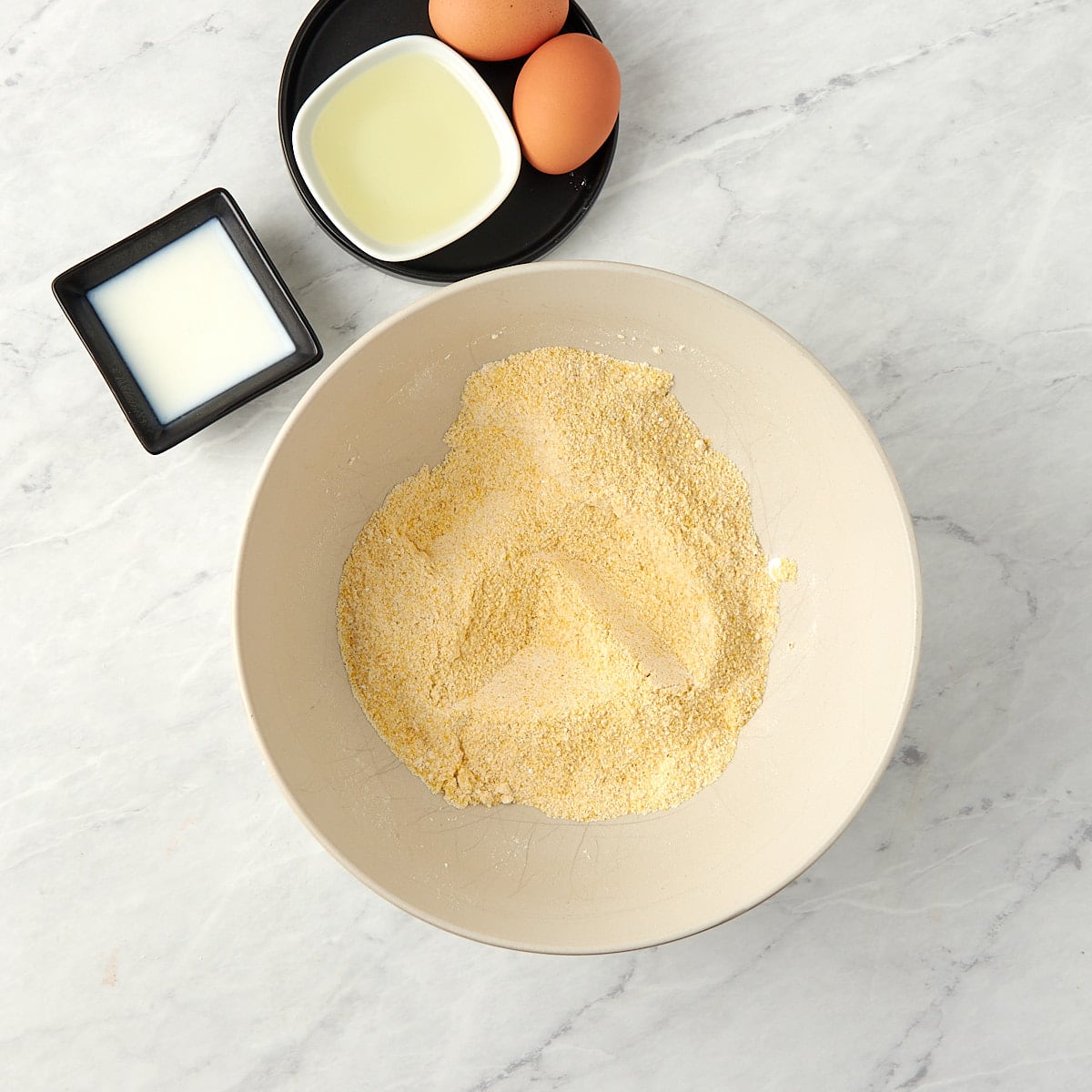
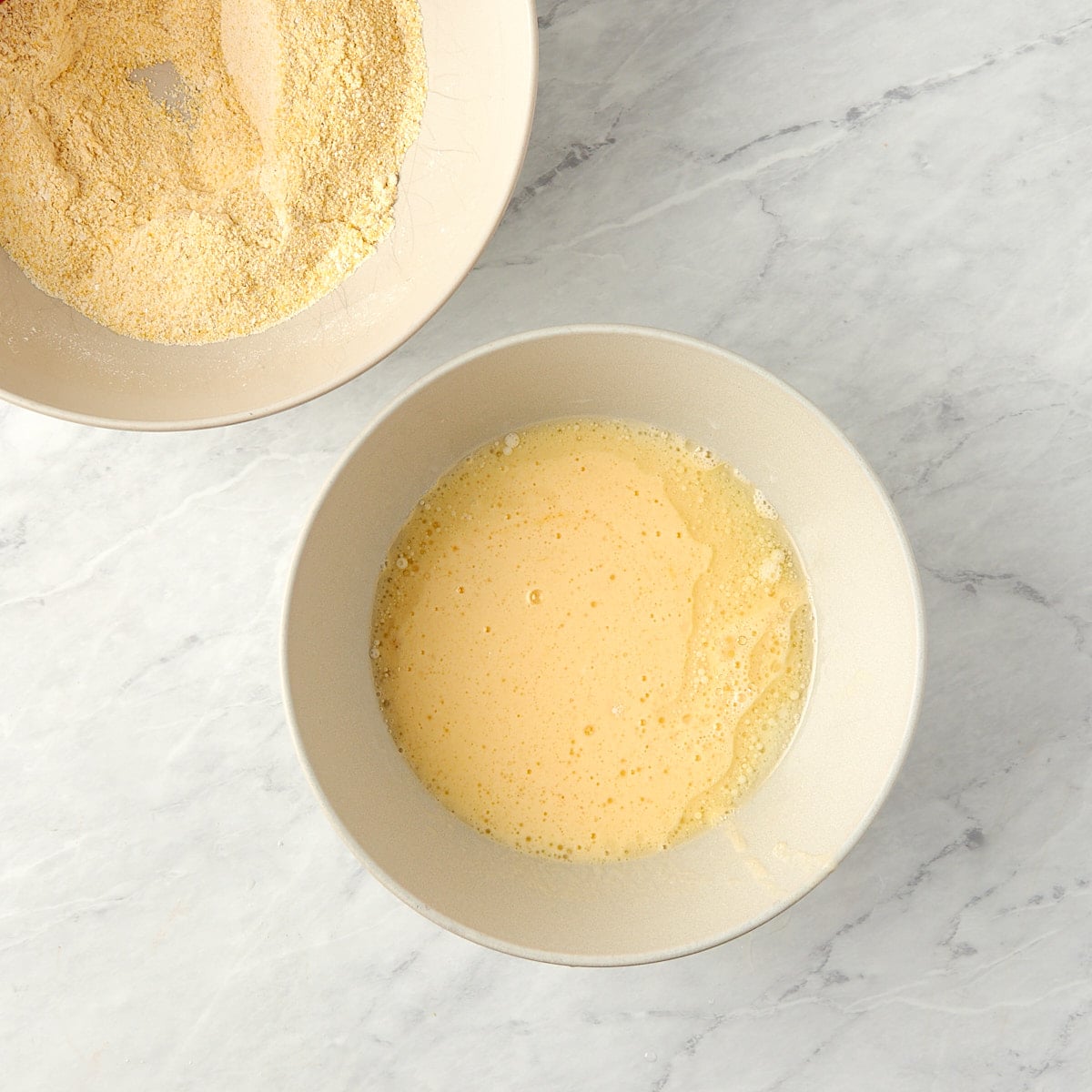
Make a well in the center of your dry ingredients and pour the wet ingredients into the well. Stir the batter just until the mixture comes together. It is okay if there are a few lumps remaining.
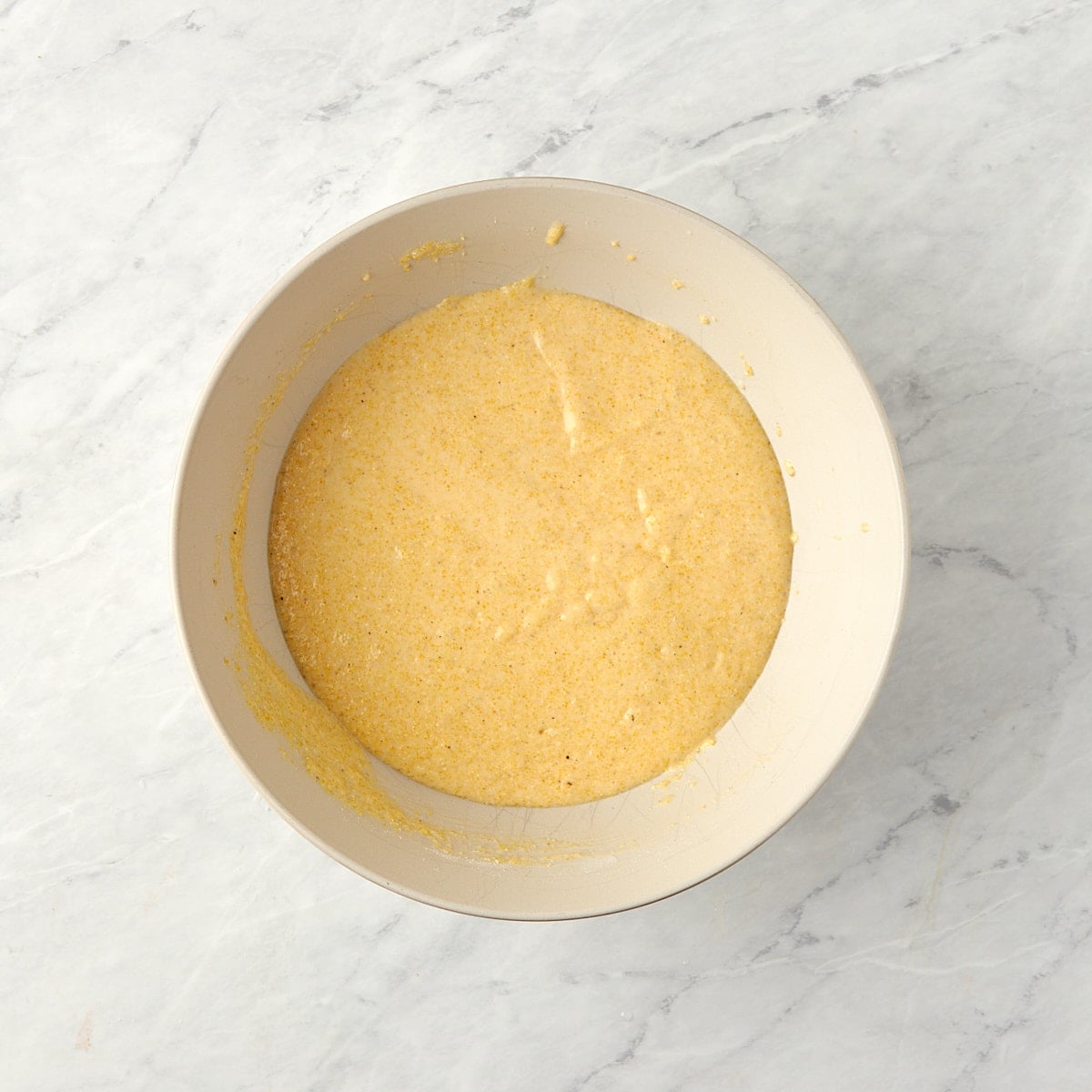
3. Bake: Pour the batter into the preheated cast iron skillet and bake for 20-25 minutes until the top is a deep golden brown and a toothpick inserted into the center comes out clean. Allow the cornbread to cool slightly before serving.

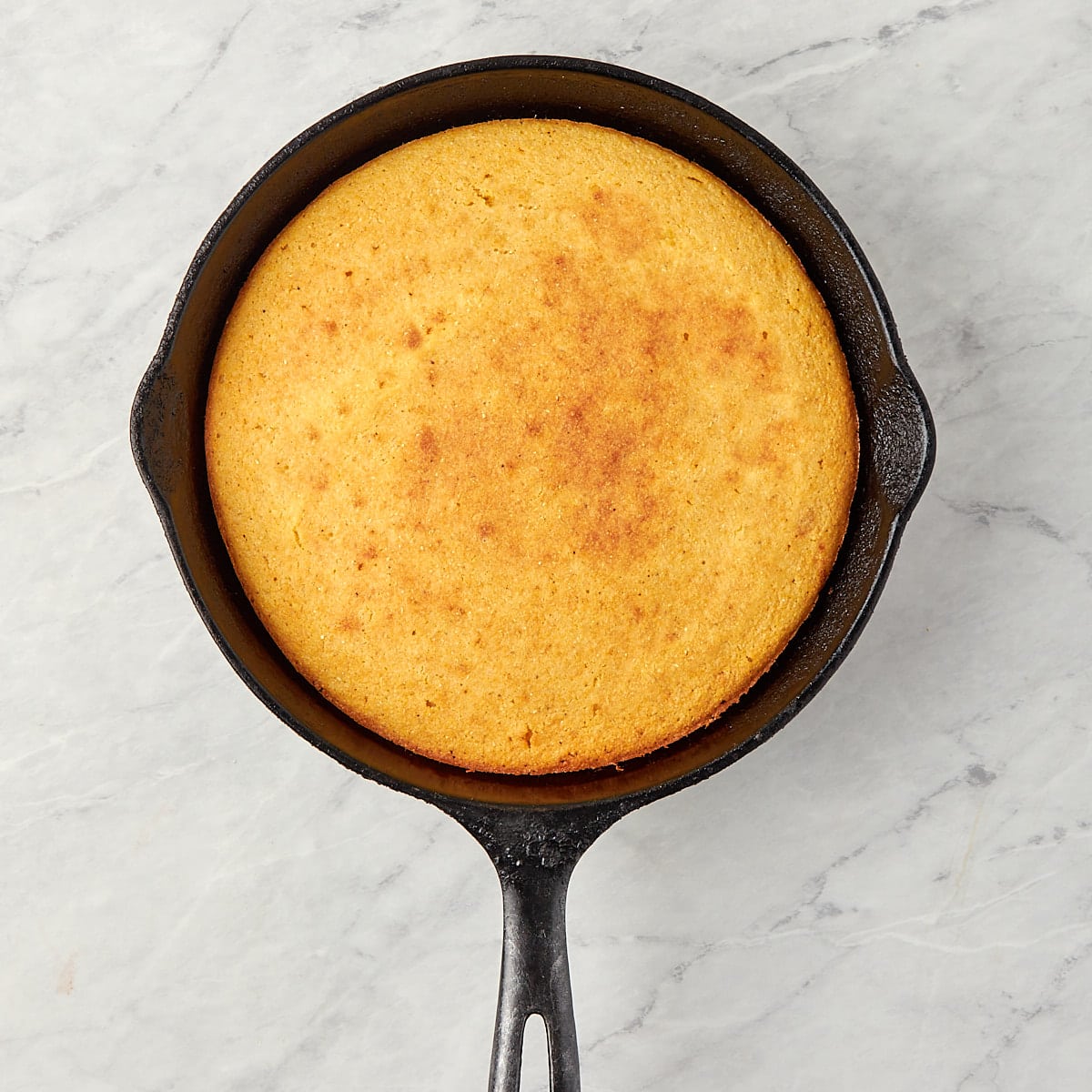
Make-Ahead and Storage
Make-Ahead: Cornbread can be made and baked up to a day in advance. To keep it moist, store it at room temperature in an airtight container to help seal in the moisture.
How to Store: Fresh cornbread is always best and to maintain the freshest taste we recommend freezing leftovers. It can be frozen for up to 3 months in a freezer safe container or bag.
How to Reheat: Allow frozen cornbread to thaw in the refrigerator and then warm it on a baking sheet covered with foil to keep the edges and top from burning or drying out. You can also add a little butter to the top or spritz it with a little water before covering with foil to help keep the cornbread moist while reheating.
Why Does My Cornbread Crumble?
Cornbread can crumble for several reasons, and understanding these factors can help you troubleshoot and achieve the desired texture in your cornbread. Here are some common reasons why cornbread may crumble:
- Too Much Cornmeal: Using an excessive amount of cornmeal relative to other ingredients can make the cornbread overly dry and crumbly. Balance the ratio of cornmeal to flour and other wet ingredients.
- Overmixing: If you overmix the cornbread batter you can develop gluten, which can make the cornbread tough and crumbly. Mix the ingredients only until they are combined.
- Overbaking: Baking cornbread for too long or at too high a temperature can cause it to dry out and crumble. Use a toothpick or cake tester to check for doneness.
- Lack of Fat: Cornbread needs some form of fat to help bind the ingredients and create a moist texture. Insufficient fat can result in a dry and crumbly cornbread.
- Using Coarse Cornmeal: If you use a coarser type of cornmeal, it can lead to a grittier texture in your cornbread, making it crumble more easily. Opt for a finer cornmeal if you prefer a smoother texture.
- Stale Ingredients: Using stale or old cornmeal, baking powder, or other ingredients can affect the moisture content and texture of your cornbread. Make sure your ingredients are fresh.
- Cutting While Hot: Cutting or slicing cornbread while it’s still hot can cause it to crumble. Allow the cornbread to cool for a bit before cutting into it to help it set and hold its shape.
Recipe Tips and Notes
- Preheat your cast iron skillet. To help prevent the cornbread from sticking and to get that nice golden brown crust make sure you pour your batter into a hot skillet.
- Let the cornbread cool. It is tempting to slice right in to fresh baked cornbread, but letting it cool will help the center get fully cooked and prevent it from crumbling.

What to Serve with Cornbread
Looking for what to serve with homemade cornbread? Try these other favorites:
- Cornbread Croutons – These small, crispy, and flavorful cubes of cornbread that are perfect topping for salads, soups, and other dishes.
- Southern Cornbread Dressing – Made with celery, onions, and sage this thanksgiving favorite but also delicious with chicken or pork. This cornbread casserole is the classic comfort food side.
- 20 Leftover Cornbread Recipes – From breakfast casseroles to savory stuffing, and even a sweet dessert twist, we have 20 recipes that will breathe new life into your leftover cornbread.
Let’s Connect! If you make this recipe or any other recipe on Casual Epicure, please don’t forget to rate the recipe and leave a comment below. It helps others who are considering making our recipes and we love hearing about your cooking experiences. And if you snapped some shots, share them on Instagram, and be sure to tag @casual.epicure so we can feature them in our stories.
Old Fashioned Cornbread
This recipe may contain paid affiliate sales links. As an Amazon Associate, I earn from qualifying purchases. Please see my full disclaimer policy for details.
Equipment
- Small Bowl
Ingredients
Cornbread
- 1 ½ cup cornmeal
- ½ cup all-purpose flour
- ½ teaspoon baking soda
- 2 teaspoons baking powder
- 1 teaspoon kosher salt
- 1 teaspoon sugar
- 1 ½ cup buttermilk
- 2 large eggs
- ¼ cup canola oil
Instructions
- Preheat oven to 400°F. Grease cast-iron skillet with vegetable or bacon grease and place in the oven to get it preheated.
- In a medium mixing bowl add the flour, cornmeal, baking soda, baking powder, salt, and sugar. Whisk to combine well.
- In a small bowl combine buttermilk, eggs, and oil. Make a well in the center of your dry ingredients and add wet ingredients. Stir just until the mixture comes together. There will be a few lumps remaining.
- Pour the batter into the preheated cast iron skillet and bake for 20-25 minutes until the top is a deep golden brown and a toothpick inserted into the center comes out clean.
- Allow cornbread to cool slightly before serving.

